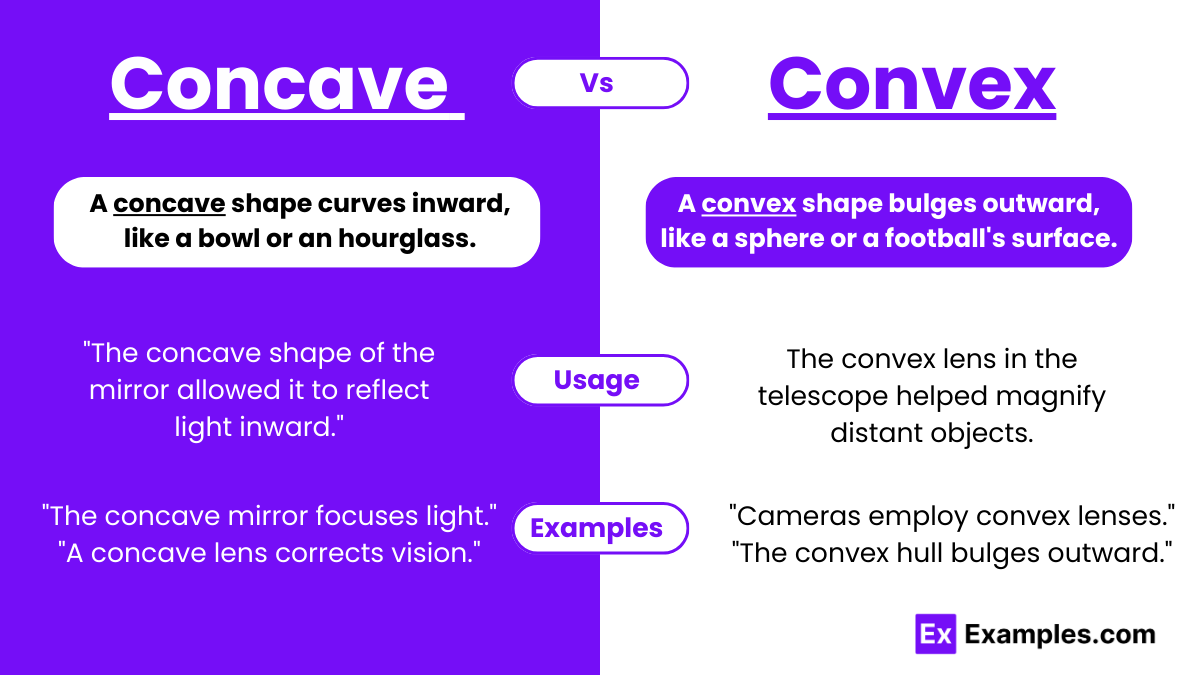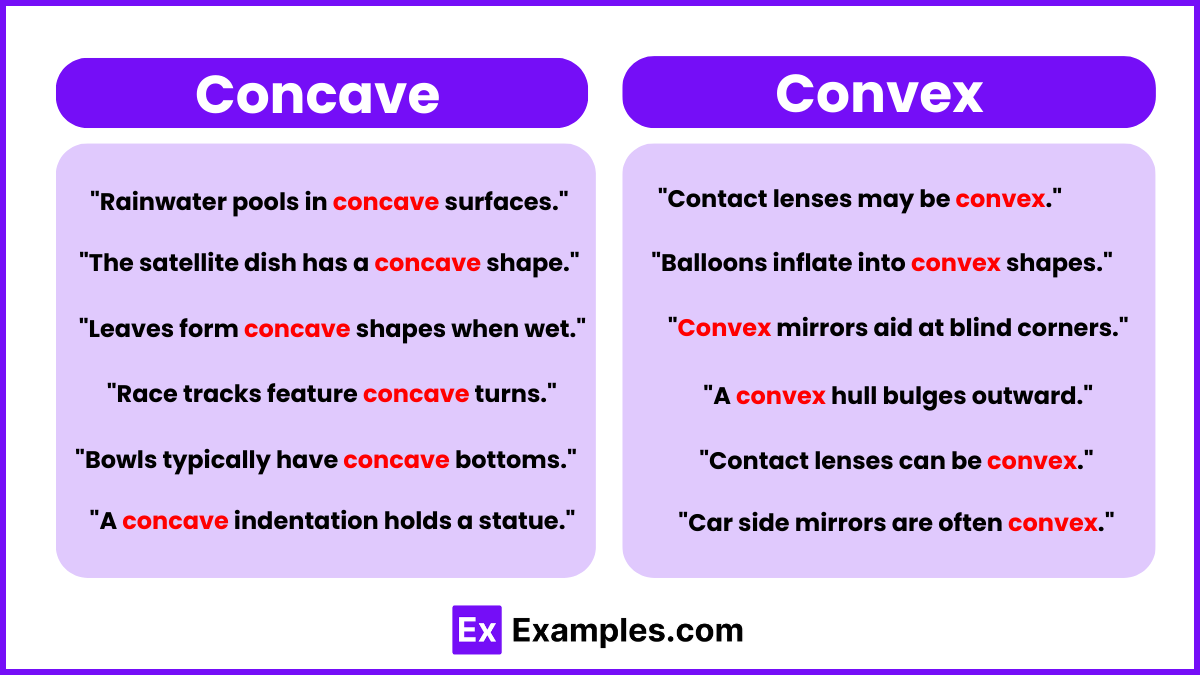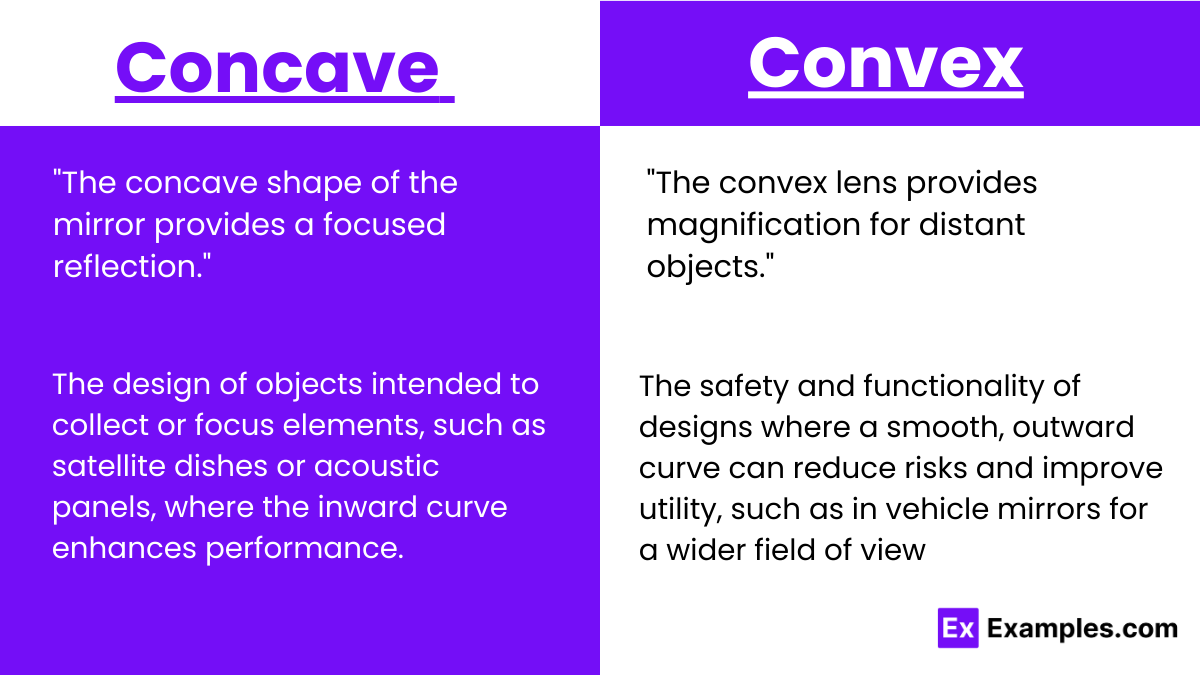Concave vs Convex – Examples, Differences, Usage, Tips
The realm of geometry and optics introduces us to the fascinating concepts of concave and convex shapes, terms that stand in stark contrast to each other by virtue of their curvature. Concave shapes, reminiscent of the inward curve of an hourglass, draw their surfaces inward, creating a cavity or depression. On the flip side, convex shapes bulge outward, mirroring the rounded exterior of a football. These descriptors go beyond mere geometric curiosity; they are foundational in understanding how objects interact with light and influence our perception, playing pivotal roles in the design of lenses for eyeglasses, cameras, and various optical instruments.
The distinction between concave and convex becomes particularly significant when discussing the behavior of light and the formation of images, whether it’s in the context of a mirror’s reflection or the focus of a lens. The inward curve of a concave lens, for example, disperses light rays, whereas the outward thrust of a convex lens converges them, each creating distinct optical effects. While these terms may not frequently punctuate everyday conversation, their application is ubiquitous in scientific and mathematical discourse, especially when exploring the principles that govern vision and imagery. This article aims not only to demarcate concave from convex but also to shed light on the underlying scientific principles that make these curvatures so consequential in our daily lives and technological applications.
Concave and Convex – Meanings
Concave and convex are terms used to describe the curvature of shapes, primarily in geometry and optics, and they represent opposite types of curvatures.
Concave: A concave shape curves inward, resembling the inner surface of a bowl or an hourglass. In a concave mirror or lens, the surface bows inward, away from the light source or the viewer. This inward curvature causes light rays to diverge or spread out when they reflect off or pass through, which can create a magnifying effect or distort the perceived image.
Convex: A convex shape bulges outward, like the exterior of a sphere or a football. In the case of a convex mirror or lens, the surface curves outward towards the light source or observer. This curvature causes light rays to converge or come together when they reflect off or pass through the surface, which can focus light and form images, or make objects appear smaller in mirrors.
Summary
Concave describes a shape that indents inward, akin to the interior curvature of a bowl, allowing it to contain or hold something within. Conversely, convex refers to a shape that protrudes outward, resembling the outer curve of a contact lens, forming a rounded, dome-like structure. Essentially, while a concave form can encompass or encase, a convex form bulges outwards, creating a raised surface. This fundamental distinction between the two types of curvature is key in understanding various natural and man-made structures, from geographical basins to architectural domes.
Difference Between Concave and Convex
In the fascinating world of geometry and optics, the concepts of concave and convex play pivotal roles in defining the shape and behavior of various objects and surfaces. Concave shapes, characterized by their inward curvature, resemble the inner surface of a bowl, offering the potential to contain or hold. In contrast, Convex shapes extend outward, similar to the outer surface of a ball, presenting a dome-like appearance. These two types of curvatures are fundamental in understanding not only geometric figures but also the principles of light reflection and refraction, which have significant implications in fields ranging from architecture to vision correction. The table below elucidates ten key differences between concave and convex shapes, shedding light on their distinct properties and applications.
| Aspect | Concave | Convex |
|---|---|---|
| Curvature Direction | Inward, resembling a cave or a hollow. | Outward, forming a bulge or dome-like shape. |
| Surface Reflection | Diverges light rays, causing them to spread apart. | Converges light rays, bringing them closer together. |
| Image Formation | Can produce magnified or reduced virtual images. | Forms diminished or real images, depending on the distance. |
| Common Uses | Used in satellite dishes, telescope mirrors, and camera lenses. | Found in car rearview mirrors, magnifying glasses, and domes. |
| Shape Examples | The interior of a bowl or a spoon. | The exterior of a ball or the surface of a bubble. |
| Optical Effects | Can create a magnifying effect. | Tends to disperse light and images. |
| In Geometry | Describes polygons with at least one inward angle. | Refers to polygons with all outward-facing angles. |
| Holding Capacity | Can hold or contain substances (e.g., bowl). | Does not have the capacity to hold due to outward curvature. |
| Mirror Types | Concave mirrors focus light, used in reflecting telescopes. | Convex mirrors disperse light, used for wider viewing angles. |
| Lens Types | Concave lenses are diverging, suitable for nearsightedness. | Convex lenses are converging, used for farsightedness |
Through this comparison, it becomes evident that concave and convex shapes each have unique attributes and functionalities, influencing everything from the design of everyday objects to advanced scientific instruments.
How do you remember the difference between concave and convex?
To remember the difference between concave and convex, consider these mnemonic aids:
- “Concave has a ‘cave'”: Think of a concave shape as being like a cave, where the surface curves inward, creating a recess or hollow space.
- “Convex starts with ‘conVEX'”: Associate the “VEX” in convex with “vexing outwards” or bulging out, which can help you recall that convex shapes protrude or bulge outward.
- Visual Imagery: Picture a concave mirror as a bowl that could hold something inside it, and a convex mirror as a ball or dome that puffs out.
- Hand Curves: Make a cupping gesture with your hand to represent a concave shape and push your hand outward to form a dome for convex. The physical act can reinforce the conceptual difference.
- “Concave caves in”: This rhyme can help you remember that concave shapes curve inward.
Examples of Concave and Convex
Understanding the examples of concave and convex shapes is essential in various fields, from physics to art. Concave shapes curve inward like a cave, whereas convex shapes bulge outward, resembling the outer surface of a sphere.
Concave Examples:
- The concave lens in her glasses corrected her short-sightedness.
- Observing the night sky through the concave surface of the astronomical telescope provided a clearer view of the constellations.
- The interior of the satellite dish’s concave shape ensures that signals are focused towards the receiver.
- Skateboarders often prefer ramps with concave curves for performing aerial tricks.
- The concave indentation on the clay pot provided a perfect grip.
Convex Examples:
- The convex mirror in the hallway allowed him to see around corners.
- A convex lens was used to focus sunlight and start a small fire during the camping trip.
- The soap bubble created a beautiful, shimmering convex surface before it popped.
- The exterior of the dome was perfectly convex, mirroring the sky above.
- Safety helmets are designed with a convex shape to deflect impact.
When to Use Concave and Convex
“Concave” and “Convex” are terms that describe the curvature of shapes and surfaces, each serving distinct purposes across various contexts.
Usage of “Concave”
- Describing shapes that curve inward, like the inside of a bowl or a spoon. This is useful in optics (e.g., concave lenses and mirrors) to discuss how light rays diverge.
- Discussing the design of objects intended to collect or focus elements, such as satellite dishes or acoustic panels, where the inward curve enhances performance.
- Analyzing certain types of polygons in geometry that have at least one interior angle greater than 180 degrees.
- Considering ergonomic designs where an inward curve can provide a more comfortable or effective user interface.
Usage of “Convex”
- Talking about shapes that bulge or curve outward, like the surface of a ball. In optics, convex lenses and mirrors converge light rays, which has implications for image formation.
- Describing the external shape of objects designed to minimize resistance or optimize interaction with external forces, such as in aerodynamics or hydrodynamics.
- Referring to polygons where all interior angles are less than 180 degrees, which is a fundamental concept in geometry.
- Evaluating the safety and functionality of designs where a smooth, outward curve can reduce risks and improve utility, such as in vehicle mirrors for a wider field of view.
Tips for Concave and Convex
Concave and Convex shapes is crucial in various disciplines, including geometry, physics, and design. Here are some tips to help you identify and use these concepts effectively:
- Visual Cue: Remember, concave shapes curve inward like a cave, while convex shapes bulge outward like the exterior of a ball.
- Reflection and Mirrors: Concave mirrors can magnify images and converge light rays, making them useful for telescopes and makeup mirrors. Convex mirrors spread light rays and create smaller, wider-angle images, ideal for security and rearview mirrors.
- Lenses: Concave lenses are diverging, spreading light rays apart and often used in corrective eyewear for nearsightedness. Convex lenses are converging, focusing light rays to a point, used in magnifying glasses and for farsighted correction.
- Geometry: In polygons, a concave shape has at least one angle greater than 180°, creating an inward dip. A convex polygon has no angles greater than 180°, with all points on the exterior.
- Design and Architecture: Use concave surfaces to create an impression of depth or to focus sound and light. Convex shapes can add volume and are often used in design for their aesthetic appeal and safety features (like bumpers).
- Functionality: Consider the functional implications of each shape in design. Concave shapes can collect or contain, while convex shapes can deflect and distribute.
- Safety: In safety equipment, convex shapes are often used to spread impact forces, while concave forms might focus energy, which is useful in situations where you want to concentrate force or sound.
- Art and Illusion: Use concave shapes to create optical illusions or dramatic effects in art, as they can distort images in interesting ways. Convex shapes can add a 3D effect, making flat surfaces appear more rounded and voluminous.
- Ergonomics: In ergonomic design, concave shapes can cradle or support, providing comfort and stability, while convex shapes might be used for handles or grips that are easy to hold and manipulate.
- Practice: Regularly observe and sketch concave and convex shapes in your environment to enhance your intuitive understanding of these concepts and their applications.
FAQs
Is Glasses Concave or Convex?
Glasses can have either concave or convex lenses, depending on the vision correction needed. Concave lenses are used for nearsightedness, making distant objects clearer, while convex lenses correct farsightedness, helping with close-up vision.
Can a Convex Mirror Ever Produce a Real Image?
No, a convex mirror cannot produce a real image. It always forms virtual, upright, and reduced images due to the way light rays diverge after reflecting off its surface.
Is the Human Eye a Concave or Convex Mirror?
The human eye functions more like a convex lens rather than a mirror. The cornea and lens of the eye work together to converge light rays onto the retina, producing a real image that the brain interprets.
Why Does a Dentist Use a Concave Mirror?
A dentist uses a concave mirror to magnify the image of teeth for better visibility. The concave shape allows for a larger field of view and helps in focusing light for a clearer, enlarged image of small details inside the mouth.





